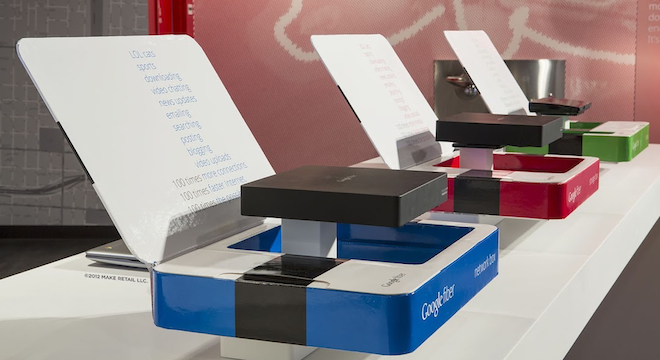Google Fiber appears to be connecting with residents of Kansas City. Just over a week after Google launched its ultra high-speed (1 gigabit) Internet service, at least 46 neighborhoods — or fiberhoods, as Google calls them — have signed-up to receive the service.
To put that number in context: That’s 22 percent of the 202 “fiberhoods” that Google has drawn up to cover households in Kansas City, Missouri and Kansas City, Kansas, two distinct cities that form one major metropolitan region on the border between Kansas state and Missouri.
Google declined to specify how many individual households had signed up to receive the service, but a spokesperson told TPM that: “Fiberhoods contain anywhere between 250 to 1500 households.”
Another firm, Macquarie Capital, estimates that Google has signed up 7,000 households, or 4 percent of the total region, as The Business Insider reported.
It’s also tough to estimate the number of households that have signed up because Google has set different benchmarks of what percentage of households have to sign up within each neighborhood before Google will begin installation of its service there. Google posts a realtime ranking of how many and which specific neighborhoods have reached their goals online here for Kansas City, Missouri and here for Kansas City, Kansas.
Some neighborhoods only have to get 5 percent of their residents to pre-register, while others must get a higher percentage of households, up to 25 percent. As Google explained in a blog post earlier this week:
All fiberhoods are different. They range in size and density as well as speed and ease of Fiber construction. For example, houses that are spread out (like in the suburbs) require more time, fiber and labor, and therefore are more difficult to connect than homes in a dense urban environment. So, in those fiberhoods that are more complicated to build, we want to make sure that enough residents will want Fiber service. We don’t want Fiber to be out of reach for anyone–it’s our hope that the pre-registration goals will be practical and attainable.
Besides that, there is the additional complication that Google is deliberately limiting the areas within Kansas City, Missouri and Kansas City, Kansas that can even pre-register whatsoever to receive the service. North and South Kansas City, Missouri, for example, aren’t yet covered by Google’s service options, but Google says it will have “second pre-registration phase” after the first one concludes in September 9.
Still, the early indications are that Google’s effort to enter and disrupt yet another industry — the Internet service provider market — is turning out to be a hit.
A number of entrepreneurs in the region are excitedly scaling up their business plans in hopes that they’ll soon be able to link up to Google’s gigabit-speed network, as The Wall Street Journal recently reported, despite the fact that Google has said that “focused on making residential connections right now.” The company did add on its blog that “we’ll have an announcement about a small business offering soon.”
Google, which hasn’t disclosed how much it is spending on the service, is certainly pushing it hard in the Kansas City metropolitan area, embarking on a slick marketing campaign that involves Google Fiber trucks driving around the city out free ice cream sandwiches from a local dairy (Google said it’s distributed 2,000 ice cream sandwiches so far) and hosting tours and a variety of free classes (pilates was one) at its “Fiber Space,” a demo store in Kansas City, Missouri. Google is also posting periodic updates about its Fiber project on a Google Plus page.
Internet service provider Time Warner was reportedly worried enough to begin offering $50 gift cards to those able to provide tips in advance of Google Fiber’s rollout.






